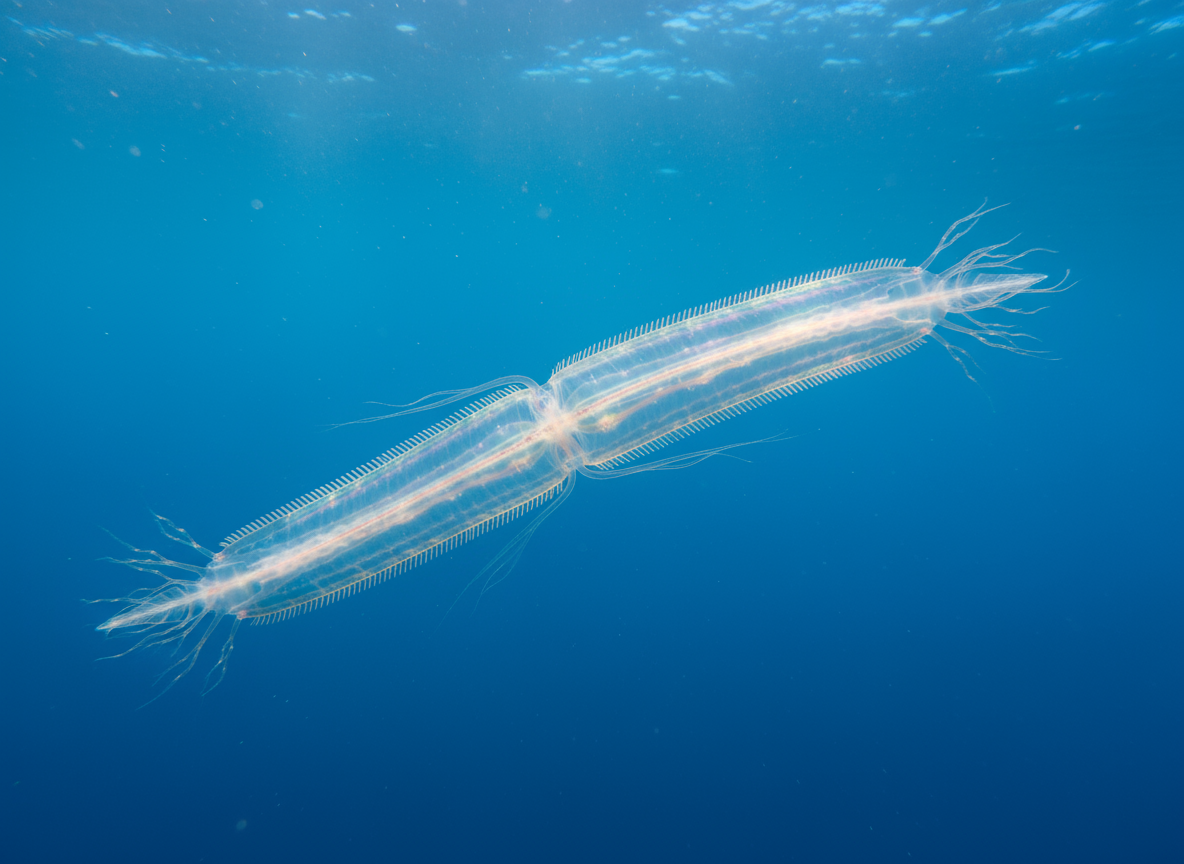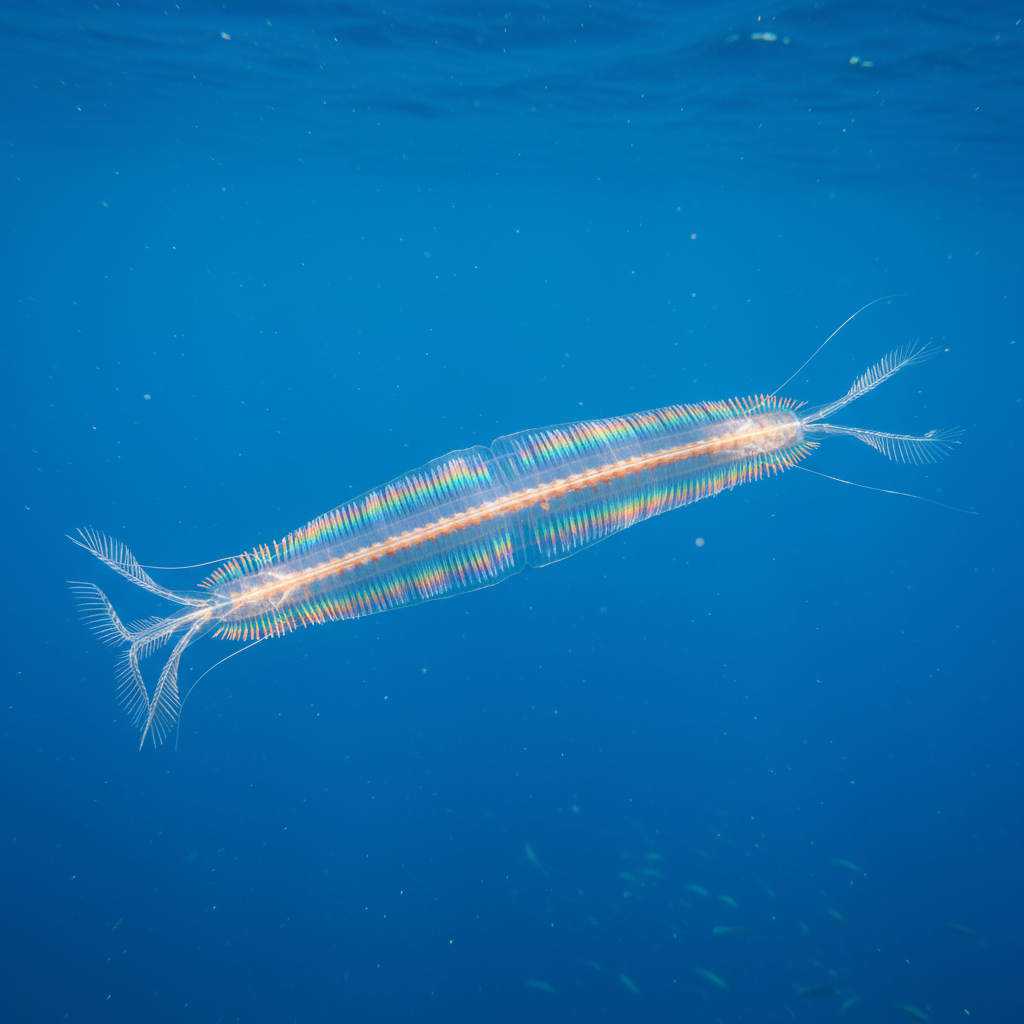Cestum: Comprehensive Insights into Classification, Habitat, and Characteristics
Classification of Cestum
- Kingdom: Animalia — Multicellular, heterotrophic organisms with complex cell structures
- Phylum: Ctenophora — Marine invertebrates known as comb jellies, possessing ciliated comb rows for locomotion
- Class: Tentaculata — Ctenophores possessing tentacles with colloblasts (adhesive cells)
- Order: Cestida — Unique ribbon-like ctenophores with flattened bodies adapted for swimming by undulation
- Family: Cestidae — Family comprising a few genera of elongated comb jellies including Cestum
- Genus: Cestum — Ribbon-shaped, flattened comb jelly known as the Venus girdle

Habit and Habitat
Commonly referred to as Venus girdle, is a pelagic marine ctenophore inhabiting the epipelagic zone of warm tropical and subtropical oceans worldwide. Characterized by its distinctive flattened, elongated ribbon-like body, Cestum is adapted to open ocean environments where it drifts with ocean currents, aided by muscular contractions and ciliary beating of comb rows.
Its habitat ranges from surface waters to moderate depths, often found in clear, warm waters where it uses bioluminescence both for predation and defense. The organism swims via undulation of its ribbon-like body, a unique locomotion pattern among ctenophores.
Geographical Distribution
Their species exhibit circumtropical distribution encompassing the Atlantic, Indian, and Pacific Oceans. Noted particularly in Caribbean waters, the Red Sea, and coastal regions of Indo-Pacific islands, Cestum’s presence correlates strongly with warm ocean currents and nutrient-rich surface waters.
Its adaptation to surface and midwater pelagic zones allows Cestum to be widely dispersed over tropical and subtropical marine regions, contributing significantly to pelagic marine biodiversity.

General Characteristics
- Commonly called as ‘Venus belt’ or girdle of venus among the comb-jellies.
- Process of transverse compression is found to such an extent that the body is elongated in the sagittal plane to a flattened transparent, gelatinous band, measuring approximately 1.5 meters in length.
- Transparent body shimmers with violet, blue or green colour.
- Four sub-tentacular comb rows are elongated to run along the entire aboral edge of the band-like body. Tentacles are reduced to tufts of filaments.
- Small lateral tentacles line the oral edge. Four interradial meridional canals arise directly from the stomach.
- Mouth is found in the mid-oral edge and statocyst on aboral edge.
- Sub-tentacular meridional canal and pharyngeal canals are present.
- Animal swims by the graceful, muscular undulations of the body and by the beating of comb or swimming plates.
- Sub-sagittal canals accompany the corresponding comb rows along the entire aboral.
- Cestum has a highly flattened, ribbon-shaped body reaching lengths up to 1.5 meters, making it one of the longest ctenophores.
- Eight longitudinal ciliated comb rows are arranged along the body’s surface, though two of the four pairs are reduced or vestigial.
- The two tentacles are short and retractable housed in sheath-like structures along the body margins, equipped with colloblasts to capture prey.
- Possesses a large mouth located on one side near the anterior, facilitating filter feeding and engulfing smaller plankton.
- The Venus girdle is transparent with a subtle violet to iridescent hue, creating an alluring spectacle in its marine environment.
- Movement is powered by combined ciliary action on comb rows and muscular undulation of the ribbon, permitting graceful and energy-efficient swimming.
Special Features
- Cestum’s ribbon-like flattened morphology is unique among ctenophores and represents an advanced adaptation to pelagic drifting.
- Bioluminescence is widespread in Cestum, featuring in predator evasion and intraspecies signaling under low-light marine conditions.
- The organism’s adhesive colloblast cells on tentacles efficiently capture planktonic prey, supporting its carnivorous diet.
- Cestum’s unusual swimming patterns have intrigued biological fluid dynamics researchers as examples of efficient propulsion in oceanic microenvironments.
- Despite its gelatinous appearance, Cestum contains structural proteins providing necessary balance between flexibility and resilience in ocean currents.

Identification
Cestum is identified by its elongated, flattened, ribbon-like body with visible paired comb rows and reduced tentacles concealed in sheaths. Its transparent, iridescent body with violet hues and remarkable length distinguishes it from other gelatinous zooplankton common in the ocean surface.
The unique undulating swimming style and presence in warm, clear tropical waters aid in field identification by divers and plankton observers.
Ecological Role and Behavior
As a carnivorous predator of planktonic crustaceans, larvae, and small fish, Cestum contributes to marine food cecles and ecosystem balance. Its relatively large size among planktonic ctenophores enables it to impact prey populations significantly.
Cestum’s bioluminescence supports diverse ecological functions, including camouflage and prey attraction. Its presence indicates healthy pelagic systems and is used occasionally in marine biodiversity assessments.
Human Interaction and Significance
Though harmless to humans, the mesmerizing appearance of Cestum enthralls divers and underwater photographers, making it an icon of marine biodiversity spectacles.
Ctenophores like Cestum are studied for their simple but efficient organ systems, and their bioluminescence molecules have applications in biotechnology and molecular biology as fluorescent markers.
Research and Conservation
This is a subject of interest in evolutionary biology, particularly within the ctenophore phylum, for understanding locomotion and sensory evolution. Its adaptation to open ocean pelagic life serves as a model for studying marine organism dispersal.
Conservation hinges on preserving oceanic health as pollution, climate change, and habitat degradation threaten open ocean and coastal ecosystems harboring Cestum populations.
References
- https://www.marinespecies.org/aphia.php?p=taxlist&tName
- https://marinebiodiversity.org.bd/species/cestum-veneris/
- https://en.wikipedia.org/wiki/Cestrum_nocturnum
- https://www.sealifebase.se/summary/Cestum-veneris
- https://www.embibe.com/exams/phylum-ctenophora/
- https://biologylearner.com/phylum-ctenophora-definition-general-characters-identifying-characters-examples/
- https://en.wikipedia.org/wiki/Cestidae
- https://www.mindat.org/taxon-2501197.html
- https://www.inaturalist.org/taxa/153458-Cestum
- https://www.britannica.com/animal/ctenophore
